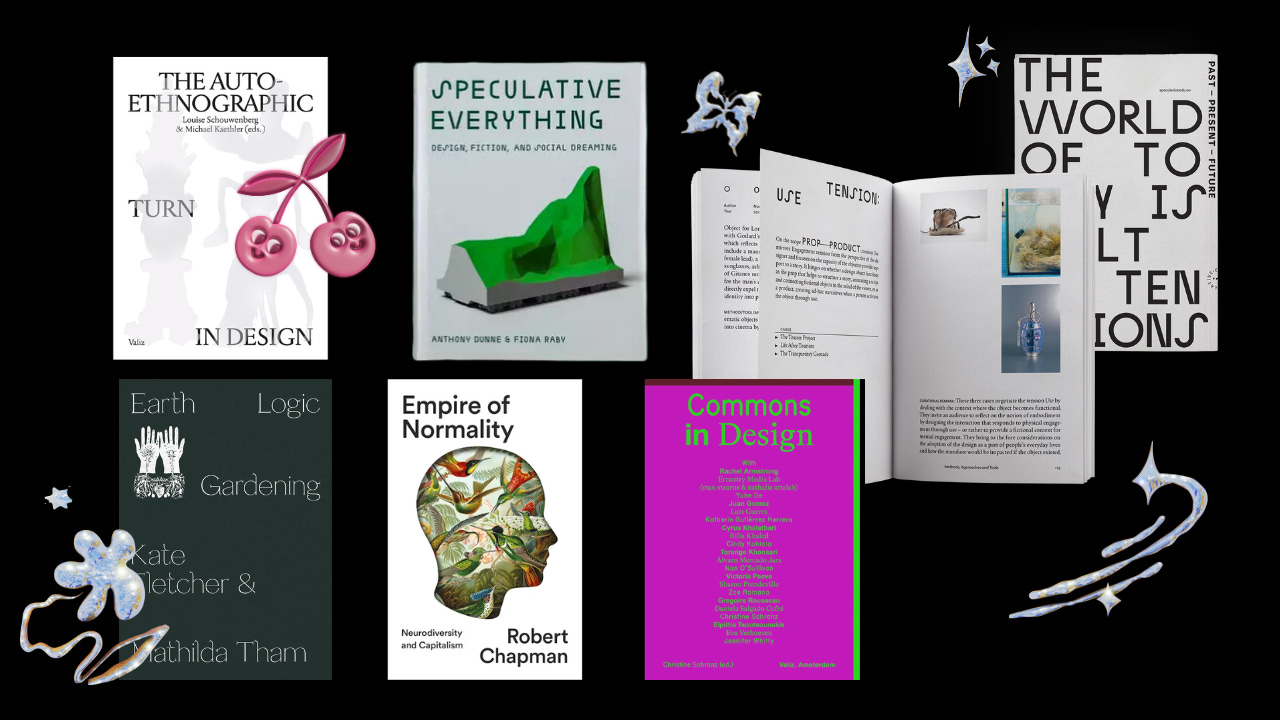some books i want to read this spring
Speculative Design, Design Commons, Autoethnographic Design and Neurodivergent Liberation, and "Planning the Garden as a Metaphor for Change"
This are some books I want to read or continue reading this coming season :) Many of them have free PDF downloads so you can join me if you find them interesting as well. Most of the text bellow are quotes from the publishing houses themselves.
Empire of Normality: Neurodiversity and Capitalism by Robert Chapman
I’ve already started this one and I want to highlight every section.
Exploring the rich histories of the neurodiversity and disability movements, Robert Chapman shows how the rise of capitalism created an 'empire of normality' that transformed our understanding of the body into that of a productivity machine.
Neurodivergent liberation is possible - but only by challenging the deepest logics of capitalism. Empire of Normality is an essential guide to understanding the systems that shape our bodies, minds and deepest selves - and how we can undo them.
Published by Pluto Press. You can listen to an conversation with the author here
The Auto-Ethnographic Turn in Design
Editors: Louise Schouwenberg en Michael Kaethler
Published by Valiz
Auto-ethnography gives an authority to the designer as someone with something to say and a means to say it
Puts forward a broad scope of what auto-ethnographic design entails: situating the designer at the heart of the research and connecting this position to the culture of design and the broader cultural realm
Contains a wide variety of both conversations as well as practices related to this important turn within design
“The book is divided between ‘Ideas and Dialogues’ (reflections and conversations between critics, theorists, educators, and practitioners), which ground conceptions of auto-ethnography and the ‘self’ and explore how experiences can be relevant and meaningful starting points for design and visual art; and ‘Projects and Practices,’ which embody auto-ethnographic qualities—whereby design objects and practices are embedded with personal sentiments, experiences, desires, fears, and more.”
Speculative Everything: Design, Fiction, and Social Dreaming by Anthony Dunne and Fiona Raby
Speculative Everything offers a tour through an emerging cultural landscape of design ideas, ideals, and approaches. Dunne and Raby cite examples from their own design and teaching and from other projects from fine art, design, architecture, cinema, and photography. They also draw on futurology, political theory, the philosophy of technology, and literary fiction. They show us, for example, ideas for a solar kitchen restaurant; a flypaper robotic clock; a menstruation machine; a cloud-seeding truck; a phantom-limb sensation recorder; and devices for food foraging that use the tools of synthetic biology. Dunne and Raby contend that if we speculate more—about everything—reality will become more malleable. The ideas freed by speculative design increase the odds of achieving desirable futures. (MIT Press)
Another book I found as I was searching this one out is Beyond Speculative Design: Past – Present – Future by SpeculativeEdu (which you can download for free here)
Commons in Design
edited by Christine Schranz
Published by Valiz, you can access their open-access PDF here
Especially “Errant Design: Design(ing) Without Solutions—An Exploration of Associative Principles for an Errant Design Practice Errantry Media Lab (by max stearns & nathalie attallah) and the multitudes of i’s and we’s contained herein”
Earth Logic Gardening by Kate Fletcher and Mathilda Tham
Planning the Garden as a Metaphor for Change
In her new Book “Earth Logic Gardering” professor of Sustainable Fashion at the Royal Danish Academy, Kate Fletcher, uses practices of gardening to nurture urgent opportunities, practices and projects of change. By this, she suggests to open up a new space for imagining fashion outside the context of economic growth.
She and co-writer Professor Mathilda Tham states: “Earth Logic shares insights gained from the heart of a broken fashion system and the huge toll it takes on people and planet. In particular perhaps, the phenomenon of fast fashion demonstrates the danger posed by human-made systems when they lose touch with the reality of Earth’s limits and with the need for social justice … This kind of fashion is actually recent; in the same way that dependency on cars or industrial agriculture are recent phenomena. Such systems are made by humans. They can be remade.”
Earth Logic Gardening is a practical guide to seeding, growing, harvesting (and more) the work of change in ways that leave old priorities and frameworks behind. Drawing upon the metaphor and practice of gardening, Earth Logic Gardening is a guide to how to root work in local communities, recognise the many other beings that live and collaborate alongside us, pay attention to how we work.
The book shares nine accessible principles for making change happen from Paying Attention to the Soil to Sorting Out the Tool Shed to Fallowing, with real life examples.
You can find a free PDF download here








